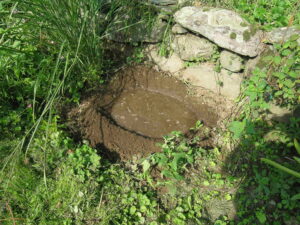A Few Tips for Growing Great Flowers
Posted on Sunday, May 28, 2023 · Leave a Comment
I’m a sucker for a good looking flower. Back when I was first developing my flower beds I would go to a plant nursery and grab everything and anything that was in bloom and looking great. And I believe in buying multiples: not one plant, but three or five! Needless to say, I was in trouble when I got home and looked for a place to plant them. I needed to create new beds for each truckload of perennials I brought home. Even so, I couldn’t help myself.
Now I am more judicious when I go shopping for plants: I decide ahead of time what I need, and how many. I decide where they will go before I leave home. Still … a few plants seduce me with their beauty every time I arrive at a good greenhouse.
By the way, I’ve heard from many gardeners that some of their perennials, trees and shrubs were damaged by a hard frost in May. Leaves that turned brown will not recover – but will be replaced. I am cutting damaged stems of perennials back to the ground and they should re-sprout. Trees and shrubs that have gone through the winter and leafed out are hardy here, and should send out new leaves on their stems, even if they don’t bloom this year. They have dormant buds that will wake up, and plenty of energy in their roots. I won’t bother taking off the dead leaves. So stop worrying if yours got frost damaged.
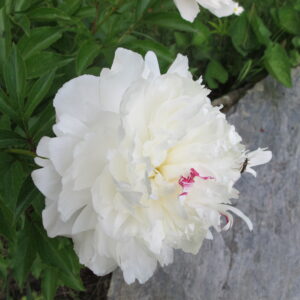
Peony ‘Festiva maxima’ that my grandmother grew
Peonies, primroses and barrenwort (which is usually referred to by its scientific name, Epimedium) are blooming in my gardens. I recommend that you buy these now, while in bloom, so you know what you are getting – and if you like them as much as I do.
Some peonies are highly fragrant, others not at all. Some have blossoms with many petals (called doubles) while others have just one or two rings of petals (called singles). Doubles are magnificent but often flop when it rains, sometimes breaking their stems. So you need to tie them to stakes or support them in wire cages made for the task. If you see both kinds in bloom, you can decide what you want to buy.
Most plants have a finite lifespan, but peonies seem to last forever. I have a division of one that was my grandmother’s – and she died in 1953. So plant them well: I dig a wide hole and add compost to it, along with some organic fertilizer – which is naturally slow release. Full sun is best, but they will do okay with 4 to 6 hours of sunshine.
Peonies can be fussy: don’t cover the little growing points beneath the soil with more than ¾ of an inch of soil, or they probably will not bloom. If yours don’t bloom, remove some soil from around them as they are probably too deeply planted.
Primroses, generally, do well in partial to full shade. Some do well in dry soil, but most like moist, rich soil. Read the plant tag carefully before planting. Sometimes I will try a plant in one place, and if, after a year or two, it is not performing well I move it. Sometimes I move a plant more than once to find the right place for it.
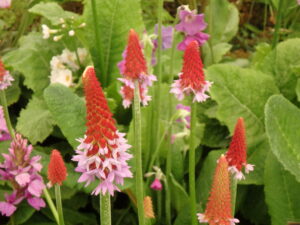
Primula vialii is not commonly sold but is wonderful
Arlene Perkins of Montpelier, VT is an expert grower of primroses. She told me long ago that all primroses like to grow under old apple trees. The partial shade is right for most, and the soil is naturally enriched by dropping leaves and fruit over time. It is under a cluster of old wild apples that I have had my best luck with primroses, particularly the candelabra or Japanese primrose (Primula japonica). They have multiplied by seed and root from a few planted 20 years ago to over 500 plants, I estimate.
Last year I planted many Primula viallii (no common name) in the perfect growing conditions for them. They bloomed magnificently last summer but so far not one has shown up again. The blossoms are very different from any I know: like little red-topped elf caps over pink/purple bases. It said to self-sow, and it is early yet, so I might see some yet.
Lastly, I love barrenwort or Epimedium. I have about eight different species or varieties of Epimedium, and all are wonderful. Epimedium grow in light to deep shade and do fine under deciduous trees, despite the competition from tree roots for moisture and minerals. My resource books tell me they do best in moist soils, but I grow them routinely in fairly dry soils. I think rich soil is the key, not the amount of moisture.
The common red one (Epimedium rubrum) blooms early in spring but hides its flowers under its leaves, which I don’t like. But it forms such a dense shade cover with its handsome leaves that no weeds will grow under it – so I forgive it.

This newly planted Epimedium ‘Pretty in Pink’ will develop into a 2-ft wide plant
The colors I grow range from pure purple to red to pink to white, with others a variety of yellows. Again, I suggest buying them in bloom – now – so you can see if the blossoms are prominent above the leaves, or hidden below. The common red one (Epimedium rubrum) blooms early in spring but hides its flowers under its leaves, which I don’t like. But it forms such a dense shade cover with its handsome leaves that no weeds will grow under it – so I forgive it.
I like “collecting” different varieties of plants I like and seeing the differences between different kinds. If one kind does well, its cousins probably will, too. So go buy more of your favorites!
Many thanks to all you readers who have donated to support
Notes from the
Garden. If you have been enjoying the column, learning from it and wish to donate, please go to my website,
www.Gardening-Guy.com and go to store/donations and follow the prompts. Or do it the old fashioned way, and mail a check to Henry Homeyer, PO Box 364, Cornish Flat, NH 03746.
Tips for Planting the Vegetable Garden
Posted on Tuesday, May 16, 2023 · Leave a Comment
Although there are many old sayings like, “Plant your potatoes when the oak leaves are the size of a mouse’s ear”, I would rather depend on soil temperature and calendar dates. Besides, who really knows the size of a mouse’s ear?
Mid-May is good for cool weather crops like spinach, peas, lettuce, onions, potatoes and broccoli-family plants. Heat-loving plants like tomatoes, cukes, zukes, corn and peppers? I have a soil thermometer and I don’t put them in the ground until it is at least 60 degrees. The date for this is usually around June 10 here in chilly Cornish Flat, but may be sooner depending on where you are.
I know you are anxious to get your crops growing, but tomato seedlings put in chilly soil and with cold nights are not happy. They don’t do much growing and may take time to recover. I’d rather keep them sitting on a sunny lawn all day and bring them in at night.

My tomatoes are hardened off, but the soil and nights are still too cold
Before you think about putting plants in the ground, please harden them off. That means introducing them to full sun over the period of a week. Start with morning- only sun, then add an hour of afternoon sun and work up to a full day of sun. Cloudy days allow you to keep them out all day, but watch out for rain. If they are in a flat that holds water, they can get too wet or get beaten flat.
I also consult with a biodynamic calendar that recommends when to plant the different categories of plants: flower, fruit, leaf and root. The one I use, called “Stella Natura” uses the position of the moon, stars and planets to determine what to plant – or more importantly, when to plant nothing.
Ask at the nursery where you buy your plants if they have been hardened off. Things like cabbage and lettuce probably are already hardened off and sitting outside the greenhouses on tables. If so, they are ready to plant anytime, but no harm in asking.
While keeping your plants happy in their little plastic six-packs, you might want to water with a dilute fish fertilizer solution. At the nursery they generally are given dilute chemical fertilizer, but I find fish fertilizer works well, and they grow strong and tall. I like Neptune’s Harvest brand.
Few of us have enough garden space for everything we want to grow, so we have to make decisions about how many tomatoes or potatoes we should grow. Ask yourself what are my favorites? Will I actually can or dehydrate tomatoes if I put in a dozen plants and we don’t eat them all in salads and sandwiches? Be realistic.
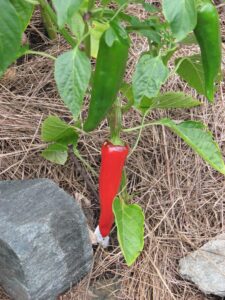
Black stones placed near heat-loving peppers help keep them warm at night
Don’t crowd your plants. Tomatoes need 24 inches between plants. Potatoes need 18 inches, onions 4 or 5 inches in rows a foot apart. Crowd them? You get more onions but smaller ones. Peppers on the other hand only need 12-inch spacing as they like to actually touch their neighbors.
A good reference guide is The Vegetable Gardener’s Bible by Vermont author Ed Smith. Even I use it from time to time, and I’ve been growing veggies for decades. Ed and his wife Sylvia really know their stuff, and buy very few vegetables in a year.
To maximize garden space I plant quick-growing plants like radishes and lettuce in between or around slower growing things like tomatoes. Plant a tomato, put it in its 54-inch support cage (never use small cages), then circle it with lettuce starts. The lettuce will be ready to eat before the tomato is big enough to shade them. I just planted my onions, and planted lettuce in the spaces between rows of onions. Don’t plant things in your asparagus patch, despite all that space, as asparagus hates company.
To maximize production, think about growing up. No, not you. Your cucumbers squashes, and pole beans. If you do this, be sure to put the trellis on the north side of your garden to avoid shading out other plants. You can buy a trellis or build your own using posts with attached chicken or welded wire with square openings.
If you want to grow hot peppers or eggplants, think about providing them some extra heat. No, not blankets. Choose dark rocks the size of a loaf of bread and place them near your plants. They will absorb heat from the sun and radiate it back during the night. You can also cover them with ReMay or row cover, a light synthetic fabric made for gardens that holds in heat and keeps bugs off.
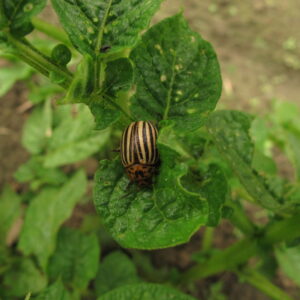
This potato beetle will lay orange egss under potato leaves. Remove them all!
Most years I have a pest called the striped cucumber beetle. It dwells in the ground and comes out at night. If I were to plant cukes, pumpkins or squashes by seed in the ground, the beetles would arrive and eat those first two leaves off right away, killing the plant. So now I start them indoors by seed and let them develop 4 to 6 leaves before I plant them outside. Sometimes I cover them with ReMay, too.
Potatoes are plagued by the Colorado potato beetle almost anywhere. I minimize the problem by planting my potatoes later in the season than my neighbors. And I look for these striped beetles, their larvae and orange egg masses. I hand pick them and then drop them in soapy water. I do that early on as they multiply quickly and each beetle will lay many eggs.
Being a good gardener takes time, but don’t be discouraged. One day you will retire and have plenty of time – even if maybe not enough energy! Just remember to take time to enjoy what you do!
Henry is a lifelong organic gardener and the author of 4 gardening books. His website is
www.Gardening-Guy.com.
Early Season Treats from the Garden and the Woods
Posted on Tuesday, May 9, 2023 · Leave a Comment
Even if you planted your peas and spinach in April, you will not be eating them anytime soon. Despite days of full sun and occasional days of high temperatures, spring in New England is often cold and rainy, too. Our vegetable gardens putter along, but few things are ready to eat until June – or later. But there are vegetables you can be eating now, however, if you plan right.

Parsnips will grow in soil suitable for carrots and are an early spring treat
I eat parsnips as soon as the snow melts and the ground thaws. How? I overwinter parsnips in the ground, which sweetens them up and makes them even tastier. I plant parsnip seeds in June – they need warm soils to germinate. Even then, they take 2 to 3 weeks to come up out of the ground.
Parsnip seeds only are good for one year, so buy new seeds each year. Plant the seeds an inch apart and half an inch deep. A key to success is to thin your parsnips so they are not crowded. Thin them in July when the greens are 4- to 6-inches tall They need 3 to 4 inches of space between plants if you want good-sized parsnips. If you mulch the plants well with ground-up autumn leaves or straw, your work is done until harvest time the following spring.
Parsnips are an old fashioned vegetable, but prepared properly they are delicious. I peel and chop parsnips into half-inch thick slices, and steam them until slightly soft. Then I cook them briefly in a frying pan with butter. At the last moment I add maple syrup and cook at low heat until it caramelizes. Yum! Don’t have any this year? You can buy parsnips at your farmers market or even the grocery store.

Sorrel is ready to eat now for me
A little-known perennial green is sorrel. Once established, it produces a plethora of light green, lemon-flavored leaves, year after year. The French make soup with it, perhaps because the greens themselves pretty much melt and disappear if you sauté them. So for years I just added them raw to salads.
Then I got Deborah Madison’s wonderful cook book, “Vegetable Literacy”. She uses sorrel with peas and leeks to make a soup. But I don’t really follow recipes, and found that yes, indeed, sorrel goes well with peas. But I found I can boil frozen peas, then at the last minute add chopped sorrel. Just boil it for another minute, drain, add butter and enjoy!
Another early perennial vegetable, asparagus, is also coming in to season. If you like asparagus – and I can’t imagine anyone not liking it steamed and slathered in butter – you should grow it. It is mostly sold as crowns (roots), not seeds, for starting a patch, but seeds are available if you want to start an acre of asparagus.
Don’t crowd your asparagus. The roots are sold in bundles of 25, which is fine for a family of two. Plant them 18 inches apart and six inches deep. Buy any of the Jersey hybrids, they are all male and won’t start new plants that will crowd out your established plants. When planting, add lots of compost and some organic fertilizer. They like full sun, and plenty of moisture, but will grow with as little as 4- to 6- hours of sunshine if that is all you can offer.
To keep on getting good asparagus every year, keep it well weeded and top dress it with organic fertilizer every year after you finish picking. Mulch is good for keeping weeds down. And don’t over-pick your asparagus: three weeks is the season for a well-established patch. Don’t pick any in year one or two. The plants need to store lots of energy for next spring’s production, so they need to grow fronds all summer for that.
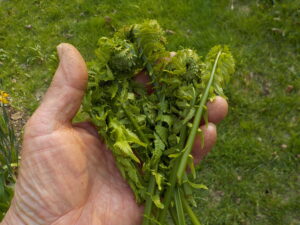
Fiddlehead stems are good tp eat, too.
Fiddleheads are a great spring treat. They are the new shoots of the Ostrich Fern, a big shade-loving fern that is common in New England. All ferns come up as fiddleheads, but only the Ostrich fern is tasty. There is an easy way to identify them: they are the only ones that have a groove up the inside of the stem – just like celery.
I sauté fiddleheads in butter in a cast iron frying pan. First I brown some slivered almonds in olive oil, then add the fiddleheads and some chopped garlic or the bulbs of ramps (more on them below). I pick not only the curled part of the fiddlehead, but also the first 6 inches of stem. But I only take one or two fiddleheads from each plant to allow it to develop well.
Ramps, also called wild leeks, are easy to grow if you have an open wooded area with maple, ash or beech. They are commonly sold now at farmers markets. Both the bulb and the leaves are edible, so cut off the bulbs and plant them. Next year they will please you by showing up in early spring. If you plant 25 to 50 bulbs each year for 3 years or more, you will develop a nice patch. Once established they will spread by seed and root.
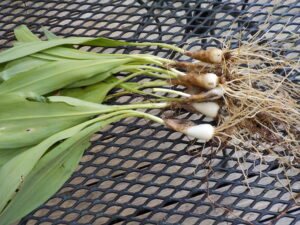
Ramps are easy to grow and a real spring treat
My favorite way of eating ramps is to clean them and rub off the gelatinous covering of the bulb, and then chop the entire plant for cooking. I fry them in a cast iron pan until the leaves wilt, then make scrambled eggs. They can also be added to anything that require garlic or onion – they are the same family.
We will have to wait until July or August to get our tomatoes, even those like ‘Early Girl’ and ‘Fourth of July’ that are quick oto produce. But if you start some perennials in your garden, you can be enjoying taste treats even now, in May. I am.
Henry Homeyer is the author of 4 gardening books. His email is
henry.homeyer@comcast.net. he is a liflelong organic gardener and a 20+-year veteran of the UNH master Gardener program.
Of course if you have been driving your car over the lawn, it is compacted and has much less air. Even walking regularly over the ground will compact the soil, which you should avoid, especially when the soil is wet. Compacted soil is not only has less oxygen, it is tough for roots to penetrate, and it is more likely to be water-logged. Crab grass does much better than planted grasses in compacted soil.
An easy test for soil compaction in your lawn is to take a screw driver with a 6-inch shaft and see if you can easily insert it into your soil. If not, it is seriously compacted. A lawn with compacted soil will improve if you spread a half-inch layer of compost over it every year. Earthworms and other soil organisms will slowly move it into the soil, improving it. Flower and vegetable beds can be loosened with a fork or hand tool.
Your soil test will not tell you how much nitrogen your soil has, as that number varies daily according to moisture levels and temperature. But if you have plenty of organic matter, it probably has adequate nitrogen. Still, I add some slow-release organic fertilizer when planting anything except annual flowers. Organic fertilizer (unlike most chemical fertilizers) slowly provides nitrogen and other nutrients, rather than all at once. This encourages healthy growth, not a fast spurt of green growth.
Two simple tests you can do involve digging holes. Dig a hole with straight edges down at least a foot to see the soil profile. The top layer will be darkest, as that is where the topsoil is – maybe just two inches, or maybe as much as six inches. The deeper the topsoil, the better. Adding compost and working it in will increase the quality of the soil; the top six inches of soil is where most plant roots are (except for trees).
The next layer is subsoil, which is a different color, perhaps a light brown or reddish brown. Finally, you may get to a layer of sand, gravel or clay. Sand or gravel will help your soil drain well, clay will act like a barrier, holding water. If the soil stays wet much of the year, it will be gray.
Drainage is important for most plants. You can test this by digging a hole 24 inches wide and about 8 inches deep. Fill it with water. If it drains out right away, or within 20 minutes, you have very good drainage. If it holds water for a few hours, especially if there has been much recent rain, you are fine. If it holds water overnight, you have a drainage problem.
If you have a drainage problem, you can build raised beds, either with wood sides or just mounded up. There are plenty of companies selling raised beds or corners for making raised beds with lumber you buy locally. Most lumber stores will cut your lumber to length.
The last test is to take a handful of moist soil, and try to form it into a cylinder. Clay soil will hold together well. Loam, which has some clay, will hold together – but break apart if you touch it with your other hand. Sandy soil will fall apart when you squeeze it. The remedy for sandy or clay soil is a generous dose of compost.
Rome was not built in a day, the saying goes. This is true for soil, too. It takes years to get your garden soil in optimum condition everywhere. So work on the places where you are planting for quicker results.













